
The Pentatomoidea are a superfamily of insects in the Heteroptera suborder of the Hemiptera order. As Hemiptera, they share a common arrangement of sucking mouthparts. The roughly 7000 species under Pentatomoidea are divided into 21 families. Among these are the stink bugs and shield bugs, jewel bugs, giant shield bugs, and burrower bugs.

Pentatomidae is a family of insects belonging to the order Hemiptera, generally called shield bugs or stink bugs. Pentatomidae is the largest family in the superfamily Pentatomoidea, and contains around 900 genera and over 4700 species. As hemipterans, the pentatomids have piercing sucking mouthparts, and most are phytophagous, including several species which are severe pests on agricultural crops. However, some species, particularly in the subfamily Asopinae, are predatory and may be considered beneficial.

Pentatominae is a subfamily of Pentatomidae, a family of shield bugs. This subfamily is the largest one within the Pentatomidae, having 4937 species classified in 938 genera. Species in this subfamily are phytophages and several of them are considered agricultural pests. Some invasive pentatomines such as Halyomorpha halys and Bagrada hilaris have been considered household pests. Higher systematics of the group have been revised by Rider et al.

Asopinae are a subfamily of stink bugs. They are predatory stink bugs that are useful as biological control agents against pests, even against other Pentatomid species, which are all herbivorous.
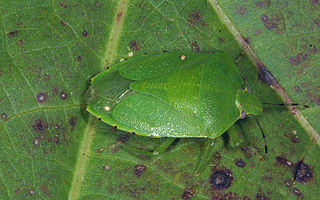
The green stink bug or green soldier bug is a stink bug of the family Pentatomidae.

The brown marmorated stink bug is an insect in the family Pentatomidae, native to China, Japan, Korea, and other Asian regions. In September 1998, it was collected in Allentown, Pennsylvania, where it is believed to have been accidentally introduced. The nymphs and adults of the brown marmorated stink bug feed on over 100 species of plants, including many agricultural crops, and by 2010–11 had become a season-long pest in orchards in the Eastern United States. In 2010, in the Mid-Atlantic United States, $37 million in apple crops were lost, and some stone fruit growers lost more than 90% of their crops. Since the 2010s, the bug has spread to the nation of Georgia and Turkey and caused extensive damage to hazelnut production. It is now established in many parts of North America, and has recently become established in Europe and South America.

Nezara viridula, commonly known as the southern green stink bug (USA), southern green shield bug (UK) or green vegetable bug, is a plant-feeding stink bug. Believed to have originated in Ethiopia, it can now be found across the world. Because of its preference for certain species of legumes, such as beans and soybeans, it is an economically important pest on such crops.
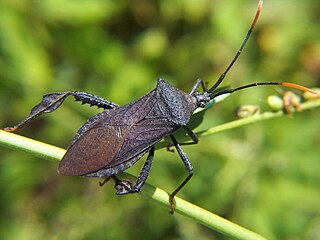
Acanthocephala, also known as spine-headed bugs, is a New World genus of true bugs in the family Coreidae. The scientific name is derived from the Greek ἄκανθα (akantha) meaning "thorn/spine" and κεφαλή (kephale) meaning "head". This name refers to the diagnostic spine on the front of the head.

Urostylididae is a family of true bugs and is considered a basal or "primitive" family within the stink-bug lineage. They are found only in Asia. Older works used the spelling Urostylidae but this clashes with the name used for a protozoan family and a spelling correction (emendation) has been suggested that also avoids the confusion created by homonyms. The family name Urolabididae has also been used for some members in the past.
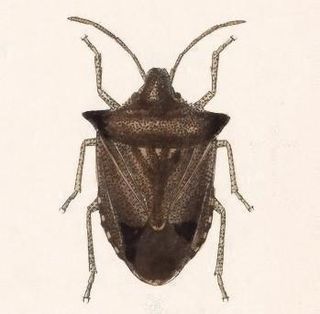
Euschistus is a genus of stink bugs in the family Pentatomidae. There are at least 20 described species in Euschistus.

Carpocorini is a tribe of stink bugs in the family Pentatomidae. There are more than 100 genera in Carpocorini.
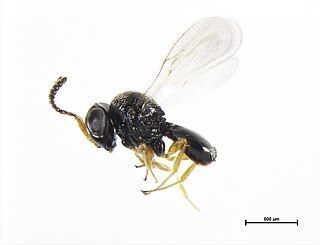
Trissolcus basalis, or the green vegetable bug egg parasitoid, is a parasitoid wasp in the family Platygastridae known primarily for parasitising the horticultural pest Nezara viridula, the green vegetable bug.

Notius is a genus of stink bugs, first described by Willam Sweetman Dallas in 1851.

Chinavia is a genus of green stink bugs in the family Pentatomidae. There are more than 30 described species in Chinavia.

Plautia is a genus of stink bugs in the family Pentatomidae. There are about five described species in Plautia, found primarily in south and east Asia and Oceania.
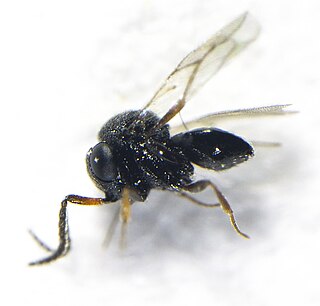
Trissolcus oenone is a parasitoid wasp in the family Platygastridae, native to Australia and New Zealand. It parasitises the eggs of stink bugs (Pentatomidae), but little is known about its biology.

Cuspicona simplex, commonly known as the green potato bug, is a herbivorous species of stink bug native to Australia and introduced to New Zealand. It feeds on nightshades. It is primarily known as a pest of potatoes, tomatoes, and other crops in the nightshade family.
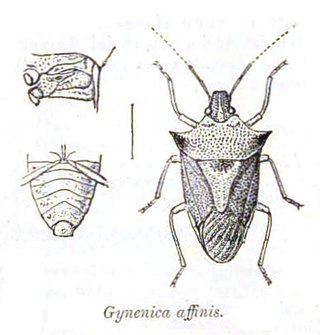
Gynenica is a genus of stink bug with about fourteen species in the Afrotropical and Oriental regions. It is one of four genera placed in the tribe Lestonocorini along with Lestonocoris, Neogynenica, and Umgababa that occur in Africa and India and feed on plants in the family Acanthaceae. Bugs in the genus have the pronotum tips extended into forward and upward curving spines. The scutellum is longer than broad, the apex with a rounded point and not reaching beyond the middle of the abdomen.

Notius depressus is a species of bug belonging to the stink bug family (Pentatomidae), first described by William Sweetland Dallas in 1851. It is found in all states and territories of Australia with the exception of the Northern Territory.

















